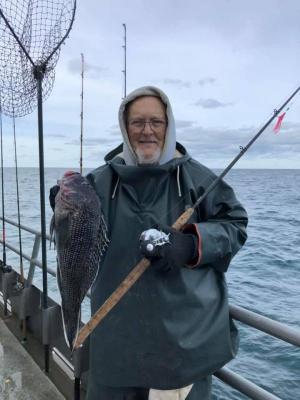At 11 p.m., Dec. 7, my son Roger and I departed Brielle, N.J., on the Big Jamaica with about 50 other hopeful anglers and headed 90 miles southeast, where we were to fish over wrecks in 200 to 300 feet of water. We arrived just as the first light was showing in the east and the sea bass were beginning to feed.
Capt. Howard Bogan had told us we would need 16 ounces of weight to hold bottom, and he was correct. Because of the sinker weight, I began using my Ambassadeur 10,000 reel on a heavy Berkley rod. That was a mistake. I soon tired out more from fighting the heavy rod and reel than the fish.
I switched to my Tsunami Hybrid 20 reel on a Tsunami Classic TSCC 761H rod, and what a difference that made. That smaller and lighter reel made cranking in fish from 300 feet, while not a breeze, certainly much easier than fighting the fish and the tackle.
I had tied up several rigs before we left and made mine single hook because I felt catching one fish at a time was about all I could handle. I do believe with the lighter Tsunami outfit I could have handled doubleheaders. I used circle hooks with fluorescent beads to attract the fish in the deep, dark water. I noticed everyone had something other than the clam or squid bait provided by the boat. Some had Gulp!, others had swim shads, twister tails, plastic squids or whatever they thought would attract the fish.
The first stop was drop and crank. As soon as the bait hit bottom, you had a fish. This lasted for awhile and then the fish grew small as all the keepers were caught. The captain moved the boat a bit on the anchor rode, and we started catching keepers again.
As each spot petered out, the captain would move to another location, which took some time. In New Jersey, head boats set two anchors so the boat stays reasonably stationary while you fish. This takes longer than setting one anchor, but in my opinion, is well worth the effort as the line stays pretty much at a 90-degree angle to the water as you fish.
Now I must tell you, when you fish with Roger Burnley, he will almost always make you look bad. Sunday was no exception. At times, he would catch two or three fish in a row before I had a bite. His biggest sea bass was five pounds, while mine was two pounds. He has set three All Tackle World Records and still holds two.
As the day went on, the captain kept moving the boat trying to find bigger fish. The first few wrecks were good, but then we began to hit spots that had already been fished hard and only found shorts, under 13 inches.
Our objective had been a 30-fish sea bass limit. We ended up with 19 to Roger’s five-pounder. We also had several big porgies, two big blues and a big ling.
The cost of the trip was $190 with $10 for a bunk. I highly recommend getting the bunk. Although their idea of a heated bunk space and my idea of a heated bunk space are worlds apart, it was great to have a place to sleep during the long ride out and back. I took a Navy blanket that I liberated from the USS Lexington in 1964 and a pillow. Roger took a sleeping bag. The sleeping bag is a better idea.
The trip is billed as an 18-hour excursion, but Capt. Bogan gave us an extra two hours to try and catch more fish. No one complained.
You will need to bring your own food. I took peanut butter and jelly sandwiches; Roger had fried chicken. We both had water and I had iced tea.
I don’t think you can beat the deal for a trip like this. Sea bass season will close Tuesday, Dec. 31, and reopen in the spring. If you want a great adventure and some good eating fish, call the Big Jamaica, 732-528-5014.
Fishing report
Rockfish have arrived off the Delaware coast. I had reports from Lewes Harbour Marina and two private boaters, with photos, of 30-plus-inch rockfish caught by trolling MOJOs and Stretch 25s and 30s. I also spoke with Old Inlet Bait and Tackle who said they had no reports of keeper rockfish from the inlet or surf.
Tog fishing continues to be lots of shorts with keepers mixed in the catch. This is true for boaters and those who fish from the rocks and sidewalks at Indian River Inlet.

























































